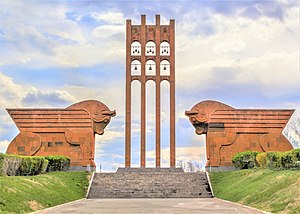Battle of Sardarapat
| Battle of Sardarabad | |||||||
|---|---|---|---|---|---|---|---|
| Part of the Caucasus Campaign | |||||||
 The memorial dedicated to the Armenian victory at the battle of Sardarabad near Araks, Armavir, Armenia |
|||||||
|
|||||||
| Belligerents | |||||||
|
|
||||||
| Commanders and leaders | |||||||
|
Daniel Bek-Pirumyan Movses Silikyan (commander of the Yerevan detachment) Tovmas Nazarbekian (commander of the Armenian Army Corps) Aram Manukian (dictator of Yerevan) |
Wehib Pasha Kâzım Karabekir (commander of the I Caucasian Corps) Rüştü Bey (commander of the 9th Caucasian Division) Zihni Bey (commander of the Zihni Bey Detachment) |
||||||
| Strength | |||||||
| 9,000 | ~10-13,000 Including Kurdish cavalry 1,500-3000 | ||||||
| Casualties and losses | |||||||
| Unknown | 3,500 dead alone from May 22 to May 26 | ||||||
Coordinates: 40°5′37.05″N 43°56′48.13″E / 40.0936250°N 43.9467028°E
Decisive Armenian victory
The Battle of Sardarabad (Armenian: Սարդարապատի ճակատամարտ, Sardarapati č̣akatamart; Turkish: Serdarabad Muharebesi) was a battle of the Caucasus Campaign of World War I that took place near Sardarabad (modern-day Armavir), Armenia from May 21–29, 1918. Sardarabad was only 40 kilometers west of the city of Yerevan. The battle is currently seen as not only stopping the Ottoman advance into the rest of Armenia but also preventing the complete destruction of the Armenian nation. In the words of Christopher J. Walker, had the Armenians lost this battle, "it is perfectly possible that the word Armenia would have henceforth denoted only an antique geographical term."
...
Wikipedia
